Plant Pest Visual Identification Guide
What’s that bug eating my plants? Identify common insect pests from photos
Most insects are not pests. In fact, out of all the millions of known species, a small minority of insects and mites cause trouble for gardeners. This photo gallery is here to help you to determine if the creatures you see in your garden are likely to help or harm your plants. Click on a insect's name or photo for a complete description.
Identify Beneficial "Bugs" in Your Garden
This category includes beetles, wasps, and other insects that are predators and parasites of garden pests. These insects are good bugs that should be encouraged to hang around your garden. They help keep your garden’s ecosystem in balance.
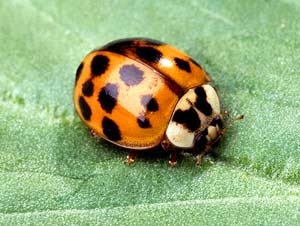 |
Ladybugs Where: On plants infested with aphids, whitefly, and mealybug Attract them with: flowers from the daisy and dill families, a water source |
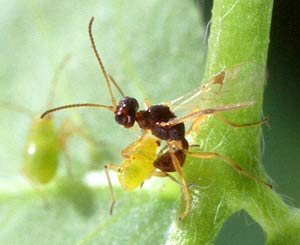 |
Parasitic Wasps Where: On plants infested with whitefly, aphids, scale, caterpillars, etc Attract them with: flowers from the daisy and dill families, a water source |
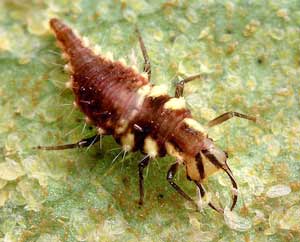 |
Green Lacewing Where: On plants infested with aphids, whitefly, mites, and mealybugs Attract them with: flowers from the daisy and dill families, a water source |
Identify & Control Caterpillars in Your Garden
They are the larval forms of butterflies and moths. They have chewing mouthparts, and their voracious feeding can quickly destroy leaves and flowers.
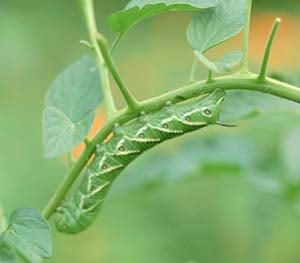 |
Tomato Hornworm Where: Leaves and fruits of vegetables (tomato family) and flowers (nicotiana) Controls: Bt, beneficial insects, handpicking, pyrethrins |
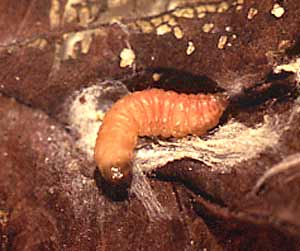 |
Codling Moth Where: Fruits of fruit trees (apples, pears) Controls: Beneficial insects, cleaning up dropped fruit, phosmet |
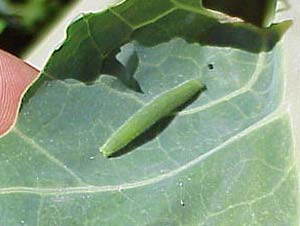 |
Cabbageworm Where: Leaves and flowers of vegetables (cabbage family) Controls: Bt, beneficial insects, pyrethrins;, row covers |
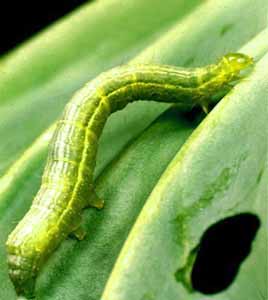 |
Cabbage Looper Where: Leaves and flowering heads of cabbage family crops Controls: Bt, beneficial insects, row covers |
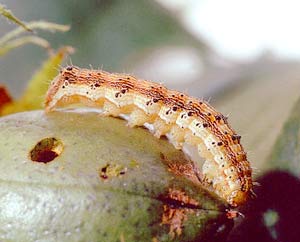 |
Corn Earworm Where: Corn leaves, silks, and kernels Controls: Bt, cultivation, mineral oil on silks |
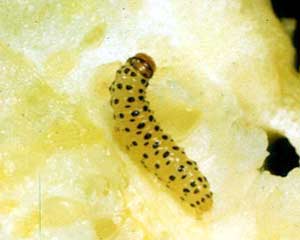 |
Pickleworm Where: Leaves, stalks, and fruit of cucumber family plants Controls: Bt, timed planting, removal of overwintering sites |
Identify & Control Beetles in Your Garden
These hard-shelled insects have chewing mouthparts. Both adults and larvae may feed on leaves and fruits, though the larvae (grubs) of some kinds, such as Japanese and cucumber beetles, feed on plant roots.
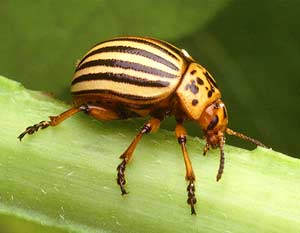 |
Colorado Potato Beetle Where: Leaves of vegetables (eggplant, potato) and flowers (nicotiana, petunia); except in California Controls: Bt, handpicking, neem, early planting, pyrethrins, row covers |
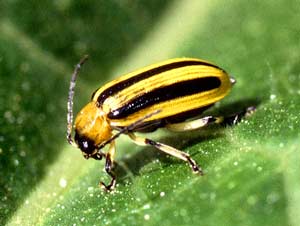 |
Cucumber Beetle Where: Leaves, flowers, and roots of many vegetables (cucumber family) and flowers Controls: pyrethrins, row covers |
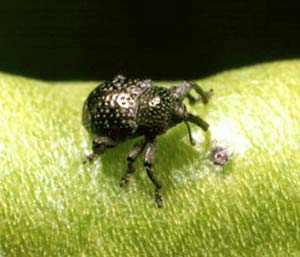 |
Curculio Where: Flowers and fruits of fruit trees (apple, peach, plum), and some flowers Controls: Clean up dropped fruit, phosmet |
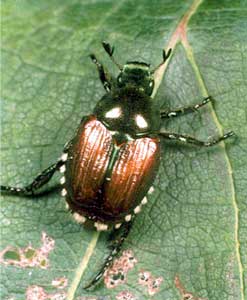 |
Japanese Beetle Where: Leaves, flowers, and fruits of fruit trees (apple, cherry, plum), vegetables (beans), flowers (roses), ornamentals (apple family); east of the Mississippi Controls: Handpicking, milky spore, neem, nematodes, pyrethrins |
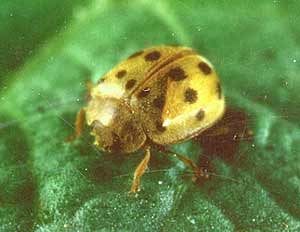 |
Mexican Bean Beetle Where: Leaves of vegetables (beans); except in the Northwest Controls: Beneficial insects, squishing eggs, neem, early planting, oil (young plants only), pyrethrins, soap (young plants only) |
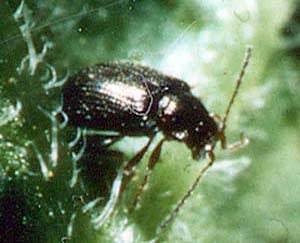 |
Flea Beetle Where: Leaves of many vegetables and fruits Controls: Diatomaceous earth, neem, oil, pyrethrins, row covers |
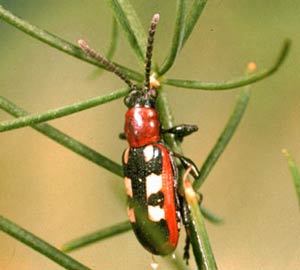 |
Asparagus Beetle Where: Developing spears and ferny foliage Controls: ladybeetles; handpicking; neem oil |
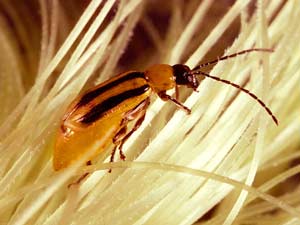 |
Corn Rootworm Where: larvae found in roots; beetles found on silks and tassels Controls: crop rotation, encourage natural predators, control weeds |
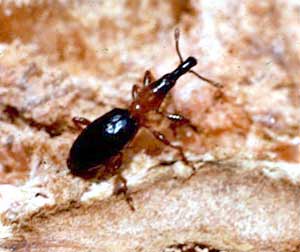 |
Sweet Potato Weevil Where: Grubs feed on roots and vines; adults feed on leaves and vines Controls: Plant certified stock, rotate crops, mound soil around base of vines, sanitation |
Identify & Control Borers in Your Garden
These beetle and moth larvae chew (bore) their way into trunks, crowns, and stems of many plants. Borers holes provide entry to infectious diseases, leading to rot that can kill plants. They are difficult to control with sprays, since spraying must be timed before the pest actually enters the plant.
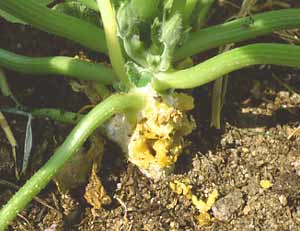 |
Squash Vine Borer Where: Stems of vegetables (squash family); except west of Rocky Mountains Controls: Bt, handpick, early planting, resistant plants (butternut squash), row covers |
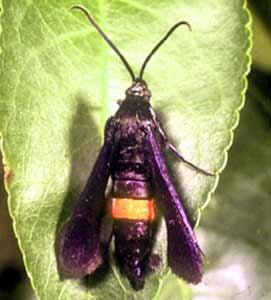 |
Peach Tree Borer Where: Trunks of fruit trees (plum, peach, cherry); except in north central and southern-most states Controls: Squish by sticking wire in hole, nematodes |
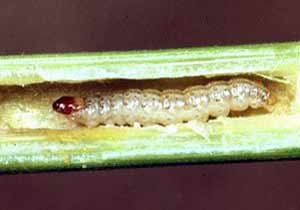 |
European Corn Borer Where: tassels, leaves, and stalks of corn; also tomatoes, potatoes, and peppers. Controls: Bt, destroy or plow under spent cornstalks |
Identify & Control Grasshoppers in Your Garden
These pests can quickly chew plants to the ground. They are mostly a problem late in the summer when the adult population is high.
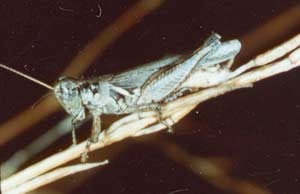 |
Grasshoppers Where: Leaves, stems, and fruits of many flowers, fruits, ornamentals, and vegetables Controls: Grasshopper protozoa (Nosema locustae), row covers |
Identify & Control Garden Pests at or Below Ground Level
This general category includes pests that damage stems, leaves, and roots from underground. They are often difficult to find, but their damage can be devastating.
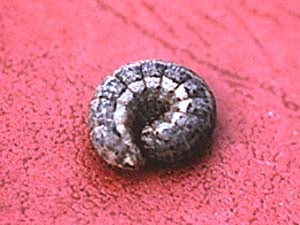 |
Cutworm Where: Leaves and stems of many flowers, fruits, and vegetables Controls: Homemade barriers, nematodes |
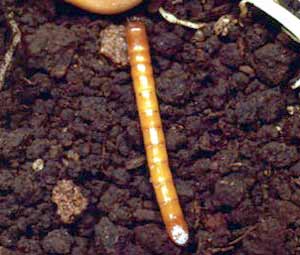 |
Wireworm Where: root crops and tubers, sown seeds of corn Controls: Cultivation, crop rotation, beneficial nematodes |
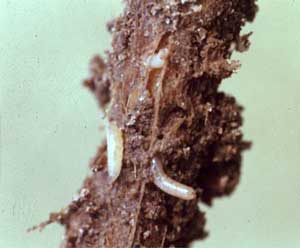 |
Root Maggot Where: Roots and fruits of vegetables (cabbage, onion) and fruit trees (apple) Controls: Homemade barriers, nematodes, row covers, sticky traps |
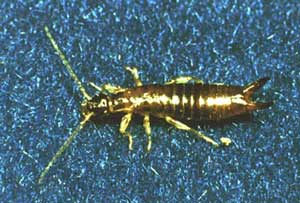 |
Earwig Where: Leaves and flowers of many vegetables, fruits, flowers, and ornamentals Controls: diatomaceous earth (DE), homemade traps, pyrethrins, soap |
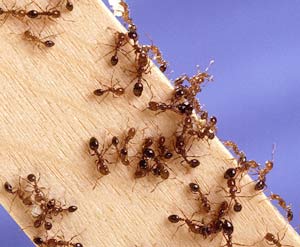 |
Fire Ants Where: In mounds in the soil and in wooden structures Controls: Beauvaria bassisana, boiling water, beneficial nematodes |
Identify & Control Small Insects in Your Garden
This catch-all group includes common insects and other hard-to-see creatures that cause obvious damage to plant parts by sucking (such as aphids, mites, and thrips) or chewing (leaf miners). Many are easily controlled if caught before their populations grow large.
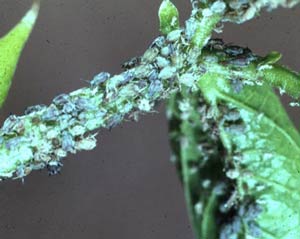 |
Aphids Where: Leaves, stems, and roots of many vegetables, fruits, flowers, and ornamentals Controls: Beneficial insects, neem, oil, pyrethrins, row covers, soap, water spray |
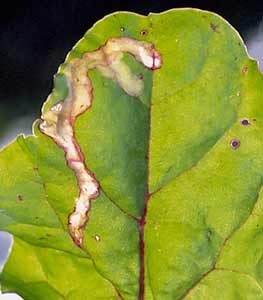 |
Leafminer Where: Leaves of vegetables (spinach), flowers (lilac), fruit trees (apple), and ornamentals (birch) Controls: neem, oil, pyrethrins, row covers |
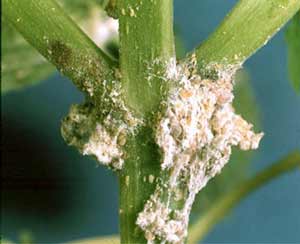 |
Mealybugs Where: Leaves and stems of many flowers, fruits, and ornamentals Controls: Beneficial insects, oil, pyrethrins, soap |
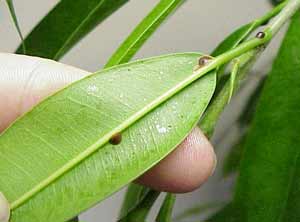 |
Scale Where: Stems and leaves of many flowers, fruits, and ornamentals Controls: Beneficial insects, neem, pyrethrins (young only) |
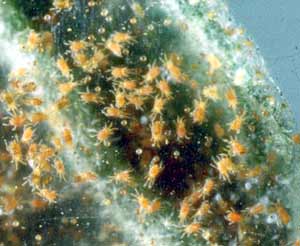 |
Mites Where: Leaves, stems, and flowers of many vegetables, flowers, fruits, and ornamentals Controls: Beneficial insects, oil, soap, water spray |
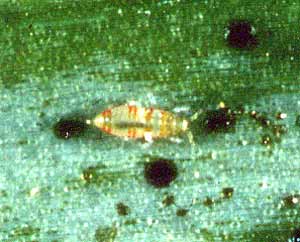 |
Thrips Where: Leaves and flowers of many flowers, fruits, ornamentals, and vegetables Controls: Beneficial insects, diatomaceous earth (DE), oil, soap, sticky traps, water spray |
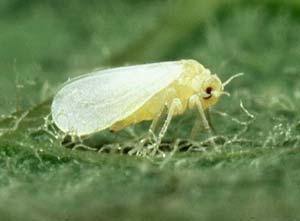 |
Whiteflies Where: Leaves, flowers, and fruits of many flowers, fruits, ornamentals, and vegetables; in the Southeast and Southwest Controls: Beneficial insects, neem, oil, pyrethrins, soap, sticky traps |
Identify & Control True Bugs in Your Garden
This group of sucking insects is best identified by the distinctive X-shape on their back. Their young (nymphs) resemble the adults and attack leaves, flowers, and fruit.
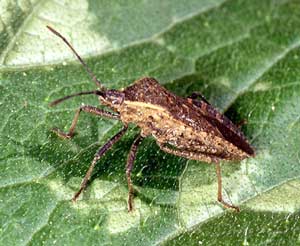 |
Squash Bug Where: Leaves and flowers of vegetables (squash family) Controls: pyrethrins, row covers, squishing eggs |
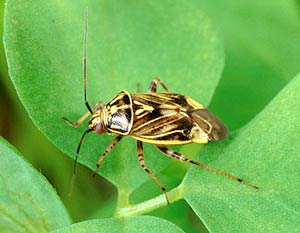 |
Tarnished Plant Bug Where: Leaves, flowers, and fruits of soft fruits (strawberry), flowers (daisy), vegetables (beet) Controls: Beneficial insects, pyrethrins (spray before flowering), row covers |
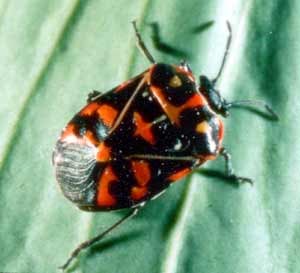 |
Stinkbugs Where: stems and shoots of tomato, potato, okra, squash, beans, and others Controls: Control weeds in the area; insecticidal soap against nymphs; cultivation |
| Questions? For more information, Ask our in-house gardening experts. |
Print this Article:
Get the Dirt
Stay up to date on new articles and advice. Please fill out the information below.
